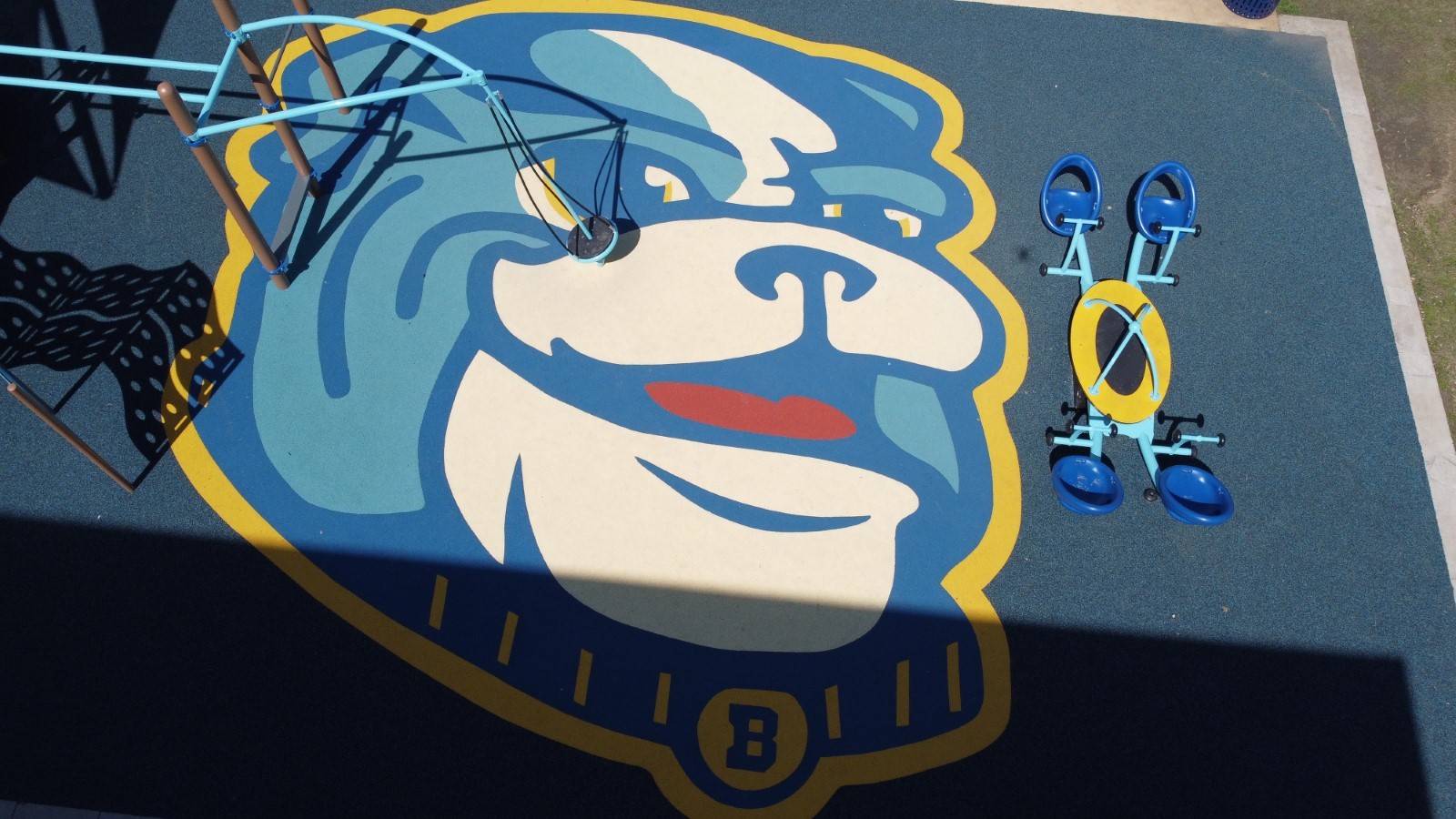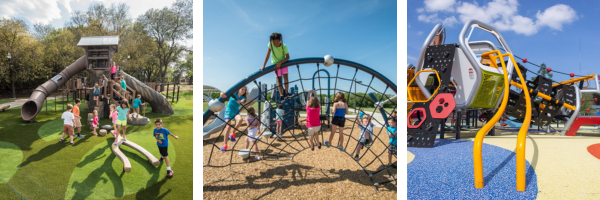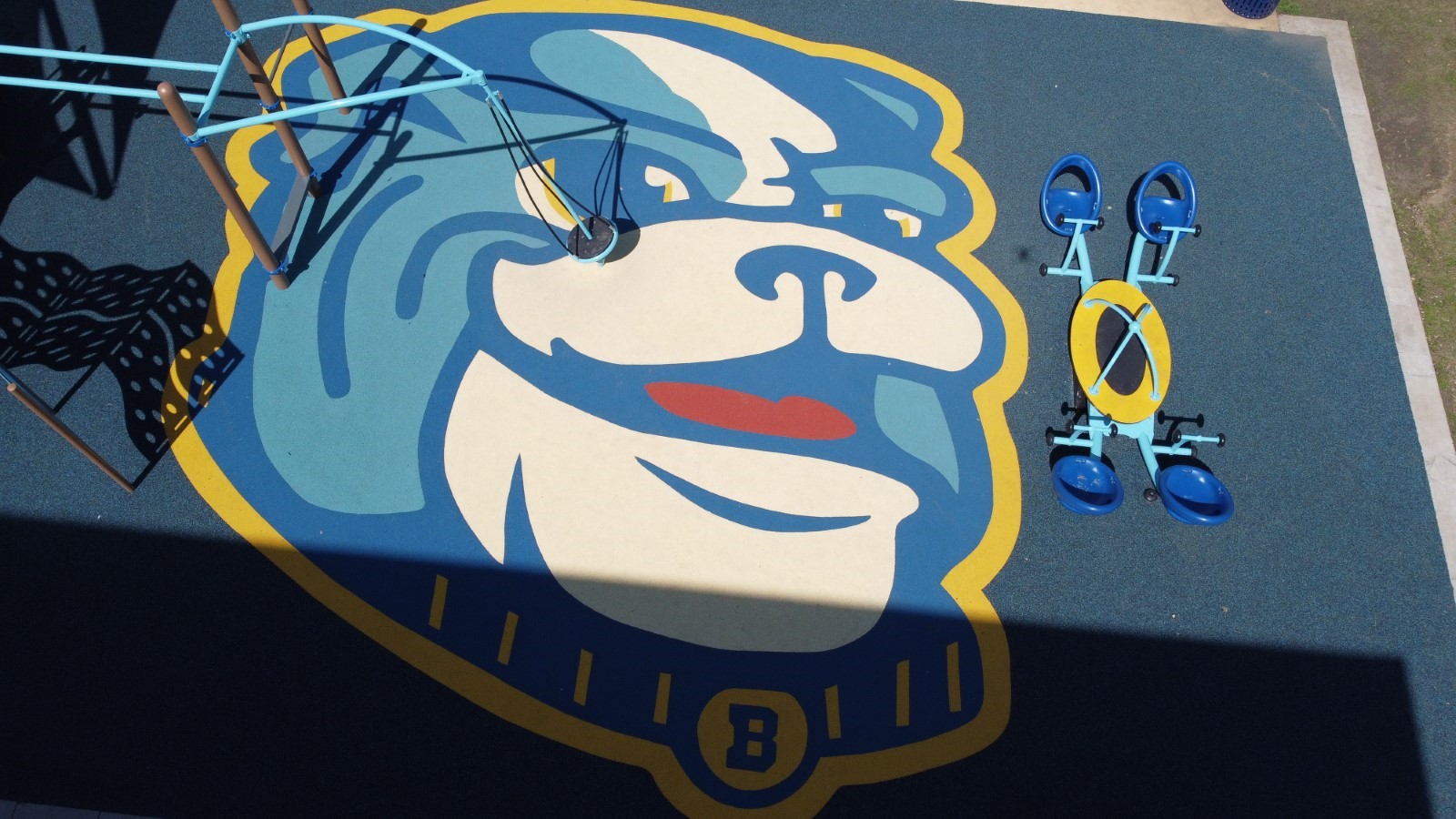Exploring Safety Surfacing: Advantages and Drawbacks
Introduction
According to the U.S. Consumer Product Safety Commission (USCPS), United States emergency departments treat over 200,000 children (ages 14 and younger) annually due to playground-related injuries. More than half of these injuries are the direct result of a fall. The surfacing of a playground is designed to provide impact attenuation, reducing the severity of injuries that can occur when children fall from playground equipment. It is often seen as the most important factor in playground safety.
To ensure playground safety, the American Society for Testing and Materials (ASTM) created basic guidelines and standards that all playgrounds are required to follow as well as, specific guidelines based on the surfacing type. The International Play Equipment Manufacturers Association (IPEMA) has also created guidelines and works to uphold consistency of compliance. Using IPEMA-certified surfacing and equipment and following guidelines set by ASTM ensures that the play space is as low-risk as possible. In addition to the guidelines set by ASTM and IPEMA, public playgrounds are also required to be compliant with the Americans with Disabilities Act (ADA), which ensures playground accessibility for every visitor, regardless of their abilities.
While there are many different surfacing materials that can be used on a playground and considered in your planning process, surfacing types fall into two basic categories, loose-fill and unitary. When deciding what surfacing to use for your playground, it is important to consider the following factors: overall safety (including impact attenuation), cost, maintenance requirements, long-term durability, aesthetics, and ADA compliance. To create the safest experience for children of all ages and abilities, it is crucial to understand these factors before making the final decision.
Loose-Fill Surfacing: Examples, Costs, Maintenance, and Guidelines
Loose-fill surfacing describes surfacing that is made up of loose materials, for example - engineered wood fiber (EWF), rubber mulch, sand, pea gravel, wood chips, and others. While these materials may initially seem affordable, there are hidden costs associated with their long-term maintenance.
Unlike unitary surfacing materials, loose-fill materials are not bound to the playground, making them susceptible to displacement and unevenness over time, particularly in high-traffic areas. The depth requirements for loose-fill surfacing, as outlined by ASTM standards, must meet shock absorption criteria at the critical fall height, which varies depending on the equipment and surfacing chosen. More specifically, ASTM F-1292 provides depth requirements for surfacing materials based on the critical and maximum fall height on a playground (these requirements vary depending on the equipment and surfacing chosen.)
Regular maintenance is crucial for loose-fill surfacing to maintain the proper depth requirements. Maintaining loose-fill surfacing will frequently require material refilling (topping off) the surface and regular raking to ensure adequate shock absorption. If the surface is not maintained at the minimum levels provided by IPEMA and ASTM, the chances of a severe injury increase significantly. Additionally, loose-fill materials allow foreign objects and debris to find their way into the playground posing a potential danger. Monthly maintenance is recommended, but for maximum safety, especially in busy playgrounds with high traffic, manufacturers recommend bi-weekly inspections.
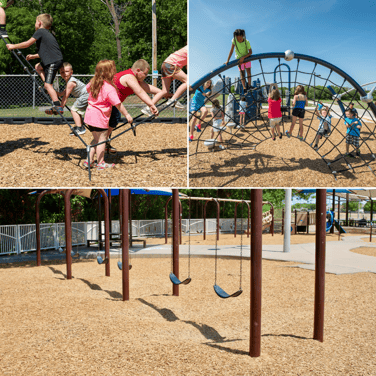 In addition to regular maintenance, loose-fill surfacing requires playground safety mats and playground borders. Playground safety mats, also known as wear mats, are typically placed in high-traffic areas of a playground; these mats are used to provide extra cushion and protection in the areas where the materials are most likely to be displaced. Borders around the playground are installed to minimize the displacement of materials outside of the playground area and limit the movement of the surface. The lifetime maintenance, play mats and border costs have to be factored in when considering this type of surfacing. These costs might seem minimal at first, but over time, can add up.
In addition to regular maintenance, loose-fill surfacing requires playground safety mats and playground borders. Playground safety mats, also known as wear mats, are typically placed in high-traffic areas of a playground; these mats are used to provide extra cushion and protection in the areas where the materials are most likely to be displaced. Borders around the playground are installed to minimize the displacement of materials outside of the playground area and limit the movement of the surface. The lifetime maintenance, play mats and border costs have to be factored in when considering this type of surfacing. These costs might seem minimal at first, but over time, can add up.
More importantly, only some loose-fill materials comply with ADA standards. For example, pea gravel, sand, and rubber mulch are not ADA-compliant and are not appropriate surfacing for public playgrounds, but EWF does typically comply with ADA standards. Although EWF is ADA-compliant, it is not the easiest surface to maneuver on for visitors who rely on wheelchairs or other mobility devices. To make a playground with a loose-fill surface the most accessible, additional paths through the playground using a unitary surfacing option and playground ramps are recommended. These extra installations ensure that everyone, regardless of physical mobility, can access the play equipment. Adding paths to the high-traffic parts of the playground and ramps going onto the playground would be another cost consideration when calculating the investment.
From a design perspective, there are few customization options available when using loose-fill surfacing. Engineered wood fiber and rubber mulch may have variations in color, texture, and size, but this can result in an uneven or non-uniform appearance across the playground surface. Because loose-fill materials are prone to displacement and scattering due to heavy use, weather conditions, and play activity, your intended design will be disrupted over time and create a less tidy appearance. Loose-fill materials, by nature, are not highly customizable in terms of designs or patterns. Unlike poured-in-place rubber or synthetic turf, loose-fill materials do not lend themselves easily to intricate designs, logos, or specific color combinations. The design options are more limited and primarily rely on the natural appearance of the material.
Therefore, while the initial installment costs for loose-fill surfacing might be more affordable than unitary surfacing options, the costs of regular maintenance, the additional construction expenses, the need for ADA compliance and the design limitations make loose-fill materials less appealing.
Unitary Surfacing: Examples, Costs, Maintenance, and Guidelines
Unitary surfacing are types of surfacing that are bound together, meaning that the surface is made to look and feel like one piece of material, making a smooth playground surface. Examples include synthetic turf, poured-in-place rubber (PIP), bonded rubber mulch, and interlocking rubber tiles. Unitary surfacing options are more costly, but may, in the long term, require less maintenance making its lifetime cost less expensive.
Compared to loose-fill, unitary materials do not move, so there is no need to “top-off” or “rake” the surface every few weeks. The installation process, however, is highly technical, adding to the expense vs. loose-fill. The higher installation costs are offset by the minimal need for maintenance of the unitary surfaces, thereby reducing the lifetime costs of your surfacing.
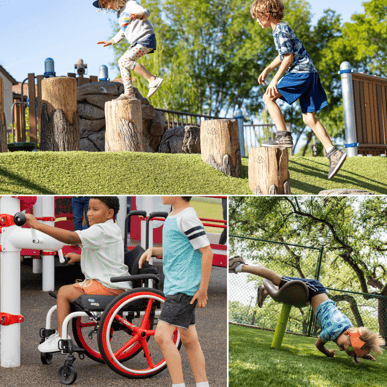 The biggest maintenance task is simply keeping the surface clean. It is advised to use a leaf blower or broom to remove debris off the surface, but because these surfaces are even and have limited texture, debris cannot get hidden underneath the surface making the process of having it removed painless. For unitary surfacing like poured-in-place and bonded-in-place rubber, manufacturers recommend getting a simple visual annual inspection to ensure there are no pits, cracks, or other damage to the surface that could cause a safety hazard. Turf and interlocking rubber tile manufacturers recommend paying attention to seams and edges to ensure that everything remains secure. PIP suppliers, specifically, recommend applying a seal coat to the rubber every two to three years; this seal coat can enhance the surface’s longevity and lifespan because it renews its wear and weather resistance.
The biggest maintenance task is simply keeping the surface clean. It is advised to use a leaf blower or broom to remove debris off the surface, but because these surfaces are even and have limited texture, debris cannot get hidden underneath the surface making the process of having it removed painless. For unitary surfacing like poured-in-place and bonded-in-place rubber, manufacturers recommend getting a simple visual annual inspection to ensure there are no pits, cracks, or other damage to the surface that could cause a safety hazard. Turf and interlocking rubber tile manufacturers recommend paying attention to seams and edges to ensure that everything remains secure. PIP suppliers, specifically, recommend applying a seal coat to the rubber every two to three years; this seal coat can enhance the surface’s longevity and lifespan because it renews its wear and weather resistance.
Unitary surfaces are significantly more inclusive and accessible than loose-fill surfaces and are the ideal choice for creating a play space that every child, regardless of physical ability, can enjoy. Out of all unitary surfacing types, poured-in-place rubber is seen as the most accessible surfacing material. This material is smooth and texture-free which makes it an ideal surface for maneuvering with a wheelchair or other mobility aids. Synthetic turf is also seen as a good option for accessibility purposes. Although its surface is not as smooth as the surface that PIP creates, it is still easy to operate most wheelchairs on it and has added benefits like slip-resistance and softness. Rubber tiles and bonded rubber mulch are also considered inclusive surfacing types but are not ideal for those who require mobility devices. Rubber tiles have gaps that make maneuvering a challenge, and bonded rubber mulch has added texture that makes the surface uneven. Overall, PIP and synthetic turf are seen as the best options for accessibility among all other surfacing types.
Unitary surfaces can also create a visually appealing playground addition. Poured-in-place rubber, for example, comes in many color options and can be manipulated into intricate shapes, designs, and patterns displayed on the surface. This surfacing option, while the most expensive, gives a visual appeal to visitors even before entering the playground. Interlocking tiles, bonded rubber mulch, and synthetic turf also come in other color variations that allow for added designs on the playground surface. These surface types, and more specifically PIP, are the best design, creative options for playgrounds.
Unitary surfaces are typically a large initial investment, but when you consider the minimal maintenance, how accessible they allow a playground to be, and the endless design possibilities, its appeal is obvious.
Conclusion
Out of the surfacing types listed, Whirlix Design recommends three surfacing types, poured-in-place rubber, synthetic turf, and engineered wood fiber. These options are the most ADA-compliant, economical, and safe for public use.
The surfacing of a new playground is a critical safety consideration. Understanding each surfacing option that is available to you and making your final decision carefully is crucial to the safety of the children who will visit the playground for years to come. Before you make the final decision about the surfacing for your new project, think about the overall safety, cost, maintenance, long-term durability, aesthetics, and ADA compliance of the surfacing types you are considering. A Whirlix Design Representative is always available should you have any additional questions.
Quick Facts: Loose-fill Surfacing
|
Surfacing Type |
Initial Investment |
Lifetime Investment |
Pros |
Cons |
Is it offered by Whirlix? |
|
Engineered Wood Fiber (EWF) |
$ |
$$$ |
- ADA Compliant - Natural look - 15-year warranty* |
- It must be properly compressed for maximum shock absorbency - Not ideal for fully inclusive space - Regular, costly maintenance |
Yes! |
|
Rubber Mulch |
$$ |
$$$ |
- Made from recycled material - 10-year warranty* |
- Not ADA compliant - Cannot be used for public playgrounds |
Yes – but not recommended. |
|
Sand and Pea Gravel |
$ |
$$$ |
|
- Not ADA compliant - Cannot be used for public playgrounds |
No. |
Quick Facts: Unitary Surfacing
|
Surfacing Type |
Initial Investment |
Lifetime Investment |
Pros |
Cons |
Is it offered by Whirlix? |
|
Bonded Rubber Mulch |
$$ |
$ |
- ADA compliant - Highly shock absorbent - Easy to clean - 5-year warranty* |
- Not ideal for inclusivity due to uneven surface texture - Pieces can become loose causing holes in the surface
|
Yes – but not recommended. |
|
Poured-in-Place Rubber (PIP) |
$$$ |
$ |
- ADA compliant - Ideal for inclusive playgrounds - Fully customizable - Low maintenance - Soft and durable - Shock absorbent - 5-year warranty* |
- Installation is technical and requires a professional - Can get hard over time depending on weather and climate |
Yes! |
|
Synthetic Turf |
$$ |
$ |
- ADA compliant - High durability - Low maintenance - Natural feel and look - Easy to clean - 15-year warranty* |
- Can produce runoff after heavy rain - Can trap bacteria - Could produce static, but there are kinds that are static resistant |
Yes! |
|
Interlocking Rubber Tiles |
$$ |
$ |
- ADA compliant - 10-year warranty* |
- Not ideal for inclusivity due to gaps - Tiles can separate over time
|
Yes – but not recommended. |
* Warranty varies based on the manufacturer

